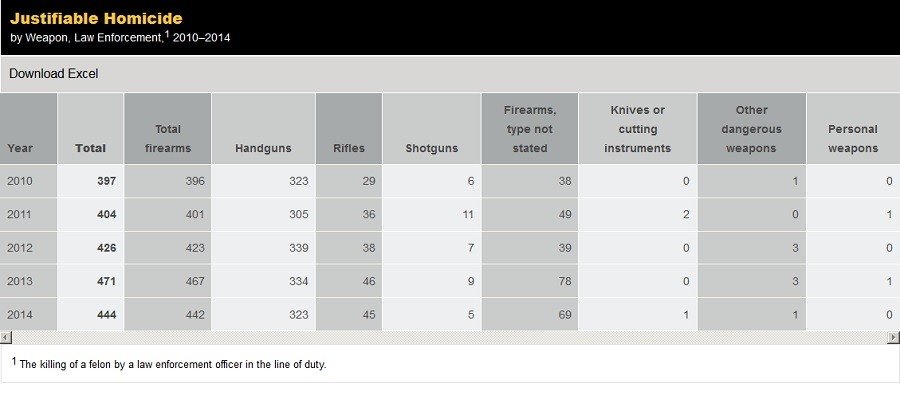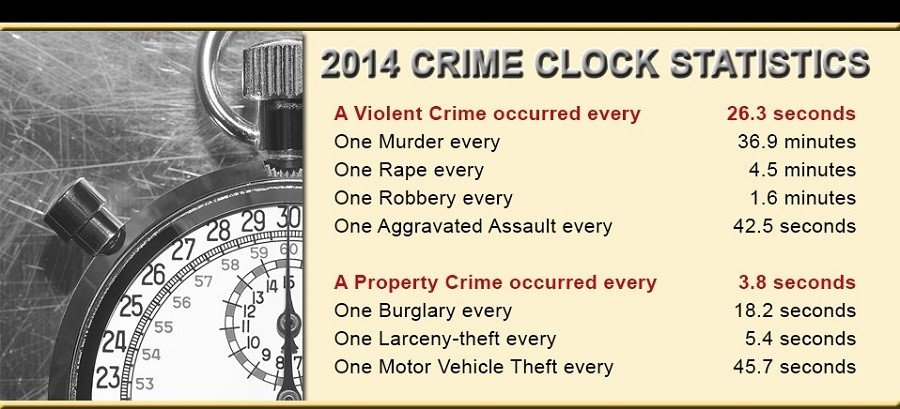FBI to report on officer-involved shootings as overall crime rate drops

The FBI will begin tracking information on officer-involved shootings for its annual crime report. However, relevant data will continue to be submitted by law enforcement agencies on a voluntary basis, leading critics to call the upcoming data unreliable.
“[T]o address the ongoing debate about the appropriate use of force by law enforcement, we plan to collect more data about shootings (fatal and nonfatal) between law enforcement and civilians, and to increase reporting overall,” FBI Director James Comey said in a message introducing the 2014 Crime in the United States report.
The report comprises statistics and information provided by law enforcement agencies to the FBI’s Uniform Crime Reporting (UCR) Program. It measures the nation’s crime problem. Currently the program only collects data on the number of justifiable homicides reported by police as well as information about the felonious killing and assault of law enforcement officers.

“As helpful as this information is, however, we need more law enforcement agencies to submit their justifiable homicide data so that we can better understand what is happening across the country,” Comey said. The data will still be collected voluntarily, though, meaning that the FBI will not create a mandatory reporting system for officer-involved shootings.
Once the FBI begins collecting the expanded data, UCR plans to add a special publication that will focus on law enforcement’s use of force in shooting incidents, the agency said. The secondary report will outline facts detailing what happened, who was involved, whether there were injuries or deaths, and the circumstances surrounding each incident.
“We hope this information will become part of a balanced dialogue in communities and in the media ‒ a dialogue that will help to dispel misperceptions, foster accountability, and promote transparency in how law enforcement personnel relate to the communities they serve.” Comey said.
BREAKING: Known people killed by police: (1) Killed By Police: 790 (2) Washington Post: 652 (3) The Guardian: 756 pic.twitter.com/ocXYgF6SPP
— Drew Childers (@PoltlFreakshow) August 31, 2015Laurie Robinson, co-chair of President Barack Obama’s Task Force on 21st Century Policing, described the current data as flawed and unreliable because of changes law enforcement agencies have made since national attention turned to the issue after a white police officer in Ferguson, Missouri shot and killed an unarmed black teenager in August 2014.
“There is a lag in the reporting of the data. The public and professional consciousness on these issues really has occurred in 2015, even though Ferguson occurred in 2014,” she told the Guardian. “So I’m not sure that one would expect there would be a dramatic change in behaviour in law enforcement in the last couple of months in 2014.”
Number of police officers killed on duty in 2014 jumps nearly 90% http://t.co/kDhN3pwiuepic.twitter.com/t40xvWMQaQ
— RT America (@RT_America) May 12, 2015Comey came out in favor of the additional reporting at the beginning of the year, saying it would lead to meaningful conversations.
“It’s ridiculous that I can’t tell you how many people were shot by police in this country,” he said during a February speech that addressed race relations between civilians and police in the United States.
During the same speech, he also admitted that there is “the widespread existence of unconscious bias. Many people in our white-majority culture have unconscious racial biases and react differently to a white face than a black face.” Comey then quoted ‘Everyone’s A Little Bit Racist’ from the Broadway musical ‘Avenue Q'.
Real quote from FBI Director James Comey's speech on race and policing today: pic.twitter.com/4JaseX9DDf
— Daniel Dale (@ddale8) February 12, 2015Along with the announcement that the FBI would begin to track data of officer-involved shootings that aren’t ruled justifiable homicides or don’t involve law enforcement personnel as the victims, the agency also released its 2014 crime statistics.
The estimated number of violent crimes reported by law enforcement to UCR’s Summary Reporting System during 2014 ‒ just under 1.2 million violent crimes ‒ decreased 0.2 percent when compared with 2013 data, continuing a 20-year trend. The estimated number of property crimes ‒ nearly 8.3 million ‒ decreased 4.3 percent from 2013 levels. Police made an estimated 11.2 million arrests last year, including approximately half a million for violent crimes.

However, the total number of violent crimes did increase in 22 states between 2013 and 2014. The largest jumps occurred in Montana, with a 29.1 percent increase; Florida, up 16.9 percent; and Nebraska, up 7.7 percent. Total violent crimes dropped the most in Vermont, an 18.1 percent decrease; Connecticut, down 9.7 percent; and New Jersey, a 9.1 percent drop.
Beginning in January 2016, UCR Program will begin collecting data for its newest initiative ‒ animal cruelty offenses ‒ as requested by the National Sheriffs’ Association and the Animal Welfare Institute.












